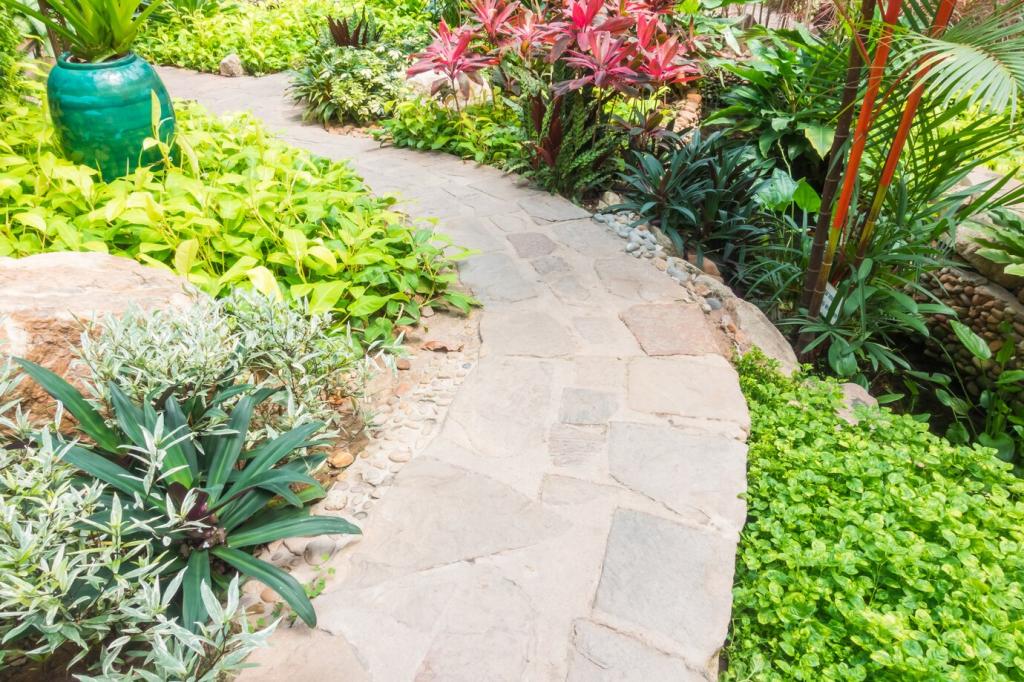Chosen theme: Sustainable Landscaping Design Principles. Welcome! Today we explore practical, inspiring ways to shape resilient outdoor spaces that save water, nurture biodiversity, and feel deeply human. Stay with us, share your ideas, and help grow a greener neighborhood together.
Start With the Site: Reading the Land Responsibly
Sustainability means different things in different contexts, but your yard can embody clear priorities: water efficiency, healthy soils, thriving habitat, and social usefulness. Write your definition, share it in the comments, and commit to three measurable changes this season.


Start With the Site: Reading the Land Responsibly
Walk your site after rain, then at noon sun, and again at dusk. Map slopes, puddles, breezes, noise, and footpaths. I once chalked arrows on my driveway to trace water flow—an afternoon experiment that reshaped my entire grading plan.
Design for Water: Conserve, Capture, and Celebrate Every Drop
Harvest Rain With Roofs, Barrels, and Cisterns
Start by calculating roof catchment area and annual rainfall to size barrels or cisterns. Direct clean overflow into rain gardens, not neighbors’ driveways. When I installed my first barrel, curious neighbors asked for plans—share yours below to help someone start today.
Build Soil Sponges With Mulch and Organic Matter
Healthy soils act like reservoirs. Each one percent increase in organic matter can dramatically improve water-holding capacity. Layer leaves, compost, and arborist chips, then let fungi and microbes weave structure. Try a square-meter test and tell us how long your beds stay moist afterward.
Irrigate Intelligently With Drip and Smart Controllers
Use drip lines under mulch, match emitter flow to soil texture, and schedule cycles in the cool morning. Smart controllers adjust for weather, but still audit for leaks each season. Download our sample schedule and add your tweaks in the comments to help fellow readers refine theirs.
Choose Native and Climate-Adapted Species
Replace thirsty lawns with climate-adapted groundcovers and regional natives. My swath of native prairie grasses cut irrigation in half and invited goldfinches by autumn. Share your top three resilient plants and tell us how they perform in heatwaves or late-spring cold snaps.
Layer the Landscape for Habitat
Design in layers—canopy, understory, shrub, groundcover, and mulch—to offer food, nesting, and shelter. The first time wrens nested in our dense shrub layer, the garden suddenly felt alive. Sketch your three-layer plan and post a photo to inspire other readers planning habitat.
Create Pollinator Pathways and Bloom Sequences
Plan nectar and pollen from early spring to late fall, then add host plants for larvae. Avoid pesticides that disrupt beneficial insects. Join our monthly bloom challenge, share what is flowering now, and help map a neighborhood pollinator pathway one yard at a time.

Compost, Cover, and Protect the Soil Food Web
Feed the underground community with compost, leaf litter, and root diversity. My backyard bin began with kitchen scraps and coffee grounds; a year later, crumbly compost changed everything. What’s your favorite carbon source? Share tips for faster, odor-free composting that neighbors appreciate.

Permeable Surfaces and Reused Materials
Swap concrete slabs for permeable pavers, gravel, or reinforced turf to infiltrate stormwater. Reuse brick, stone, or urban lumber to cut embodied energy. I love the character of reclaimed edging—post your best salvage find and how you adapted it to your site’s drainage patterns.
Microclimates, Energy, and Climate Resilience
Shade and Orientation for Passive Cooling
A deciduous shade tree on the west can trim summer cooling loads dramatically while allowing winter sun. After planting two oaks, our afternoon rooms ran cooler even during a heat dome. Which side of your home overheats most? Share your shade strategy and tree shortlist.
Windbreaks, Sun Traps, and Thermal Comfort
Use evergreen windbreaks to slow winter winds and hedges to guide breezes in summer. Create sun traps with stone and reflective surfaces for shoulder seasons. My courtyard finally became usable in March—tell us how you’ve shaped microclimates to extend your outdoor time.
Design for Fire, Flood, and Drought
Adopt defensible space zones, plant fire-resistant species, and clear debris near structures. Shape swales and rain gardens for flood pulses, then choose drought-adapted palettes. After a sudden storm, our bioswale captured runoff beautifully; subscribe for our resilience checklist and share your lessons learned.
Leave hollow stems for overwintering bees, mow lawns high, and prune with purpose after nesting season. A once-a-year meadow cut keeps structure and wild charm. Grab our printable maintenance calendar and tell us which task saves you the most time and water.
